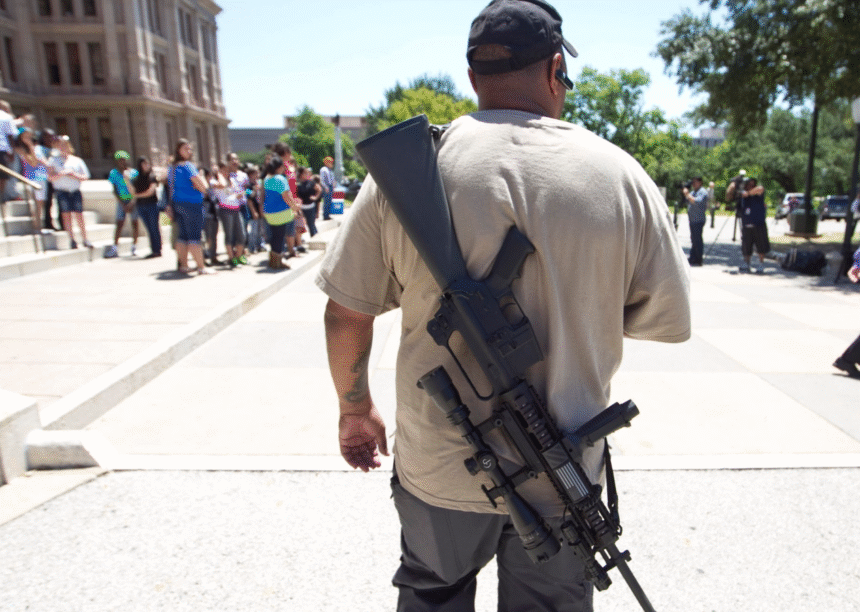Oklahoma’s open carry laws give residents the right to visibly carry firearms in public, provided they meet licensing and age requirements. While this law aligns with Second Amendment protections, it also raises serious legal questions, particularly when firearms are involved in personal disputes that result in injury. In some cases, what begins as a heated argument can escalate into an assault claim, especially when one party openly carries a weapon.
For victims, the presence of a visible firearm can create heightened fear, intimidation, and confusion about how to respond. In legal terms, these situations blur the line between self-defense and aggression, making personal injury and assault claims more difficult to pursue without experienced legal guidance.
Understanding Oklahoma’s Open Carry Rights
Under current law, Oklahoma residents who are at least 21 years old, or 18 if in the military, may openly carry firearms without a permit. The law covers both handguns and long guns and applies in most public spaces, with some exceptions like schools, government buildings, and private properties that prohibit firearms.
While open carry is legal, it comes with serious responsibilities. Brandishing a weapon, using it to intimidate others, or escalating conflicts while armed may still lead to criminal charges or civil liability. The law protects your right to carry, but not to threaten or harm others.
Why Open Carry Complicates Assault and Injury Cases
When a firearm is present during a physical altercation or confrontation, the stakes are dramatically higher. Even if the gun isn’t discharged, its presence can cause emotional distress, perceived threats, or panic that leads to unintended injuries. For plaintiffs, proving an assault claim becomes more complex when the defendant claims open carry rights as a defense.
This is where Oklahoma Injury Law Firm, the best personal injury law firm in Oklahoma, plays a critical role. Their attorneys understand the nuanced interplay between open carry laws, assault statutes, and personal injury claims. They know how to challenge false self-defense claims and prove when a visible firearm contributed to a threatening or harmful situation.
The Legal Difference Between Threat and Self-Defense
One of the most contested aspects of open carry incidents is whether the gun owner acted in self-defense or crossed the line into assault. Oklahoma law allows individuals to defend themselves when they feel threatened, but that defense must be proportional and reasonable.
If a person uses a gun to intimidate, escalate an argument, or create fear without justification, they may be held liable for assault, even if no shots were fired. Courts closely examine the context of the altercation, the presence of credible threats, and whether the weapon was introduced unnecessarily or irresponsibly.
Emotional Distress Claims Involving Firearms
Even when no physical injury occurs, the presence of a weapon can create intense fear or trauma. Victims may suffer from anxiety, PTSD, or emotional distress after being threatened or intimidated during an encounter involving an openly carried firearm.
These psychological injuries can be compensable under Oklahoma personal injury law. However, proving emotional distress requires detailed documentation, expert testimony, and a legal strategy that clearly shows how the defendant’s actions, while legally armed, caused harm. Skilled attorneys help victims build strong cases that highlight the lasting impact of such traumatic events.
Property Owner Liability in Gun-Related Incidents
Businesses and private property owners have a responsibility to maintain safe environments for their customers and guests. If a gun-related altercation happens on their premises, especially if it involves an employee or recurring safety complaints, the property owner may be partially liable for failing to prevent foreseeable harm.
This includes situations where staff fail to de-escalate conflicts or knowingly allow armed, aggressive individuals to remain on the property. Premises liability laws may apply in these cases, and victims should explore whether the environment contributed to the risk they faced.
When Children or Bystanders Are Involved
Assault and injury claims become even more serious when minors or uninvolved bystanders are affected. A visible firearm in a chaotic setting can cause children lasting trauma or even physical injury during a panic or crowd response. In Oklahoma, the law tends to be especially protective of children’s rights in personal injury claims.
Parents may be able to pursue damages for emotional and physical harm done to their children, including therapy costs and long-term emotional impact. In such cases, legal teams will focus not only on the direct actions of the gun carrier but also on broader negligence that allowed the situation to unfold.
Challenges in Proving Negligence or Intent
Proving negligence or intent in open carry incidents can be challenging, especially when evidence is limited and both parties offer conflicting accounts. These cases often hinge on nuanced details, making early legal investigation essential. Key challenges and strategies include:
- Conflicting Testimonies- Many open carry disputes become word-against-word scenarios, with each party claiming the other provoked or escalated the encounter.
- Lack of Video or Witness Evidence- In the absence of surveillance footage or third-party witnesses, it’s difficult to prove whether a firearm was displayed recklessly or with intent to intimidate.
- Claims of Lawful Conduct- Defendants frequently argue they were merely exercising their legal right to openly carry a firearm, making it harder to establish wrongful intent or behavior.
- Need for Thorough Legal Investigation- Early evidence gathering—such as locating witnesses, preserving surveillance footage, and documenting the scene—can be critical in reconstructing what truly happened.
- Uncovering Inconsistencies- A strong legal team will closely examine the defendant’s narrative for contradictions, inconsistencies, or statements that don’t align with physical evidence.
In these cases, building a compelling argument requires more than speculation—it demands factual support uncovered through diligent legal work and timely investigation.
Why Legal Representation Is Crucial in Gun-Related Injury Cases
Injury claims involving firearms are among the most complex in civil law. They involve overlapping statutes, constitutional rights, and often significant emotional trauma. Victims who try to handle these claims alone face tough opposition—and potentially unfair outcomes.
Working with an experienced personal injury attorney ensures your rights are protected and your story is fully heard. Legal professionals can negotiate settlements, challenge defenses, and present compelling arguments that hold reckless or threatening individuals accountable, even when they claim to be “just carrying legally.”














